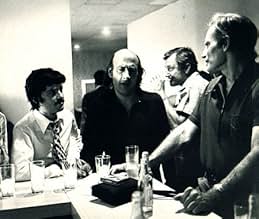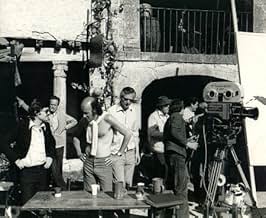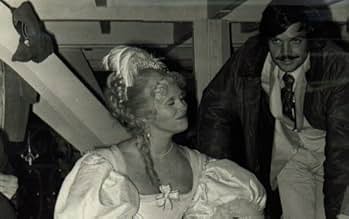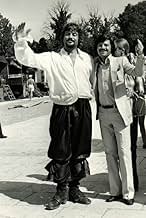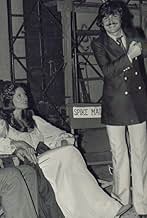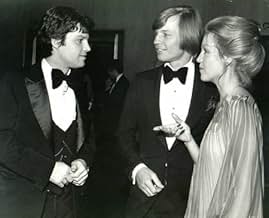NOTE IMDb
7,1/10
21 k
MA NOTE
Un jeune bretteur est confronté à son arrivée à Paris à des brigands, au fil de ses aventures composées de romance et d'intrigues, il se lie d'amitié avec trois mousquetaires.Un jeune bretteur est confronté à son arrivée à Paris à des brigands, au fil de ses aventures composées de romance et d'intrigues, il se lie d'amitié avec trois mousquetaires.Un jeune bretteur est confronté à son arrivée à Paris à des brigands, au fil de ses aventures composées de romance et d'intrigues, il se lie d'amitié avec trois mousquetaires.
- Réalisation
- Scénario
- Casting principal
- Nomination aux 5 BAFTA Awards
- 4 victoires et 7 nominations au total
Jean-Pierre Cassel
- King Louis XIII
- (as Jean Pierre Cassel)
Avis à la une
Richard Lester has to be one of the greatest directors of comedy there ever was. There are dozens of slapstick gags and situations in this movie and almost 100% of them work. And what an opulent setting they are placed in! Lester and his cohorts have created a film in which almost every frame resembles a museum painting come to life (and gone berserk.)
Lester is better with style than relating a narrative. I found it impossible to completely comprehend the story line here, and I think if you asked most people what the movie was about, they'd tell you there was a lot of swashbuckling and general mayhem and lunacy, but I doubt they'd give you much of Dumas' story. When the style is this good, however, a little fuzziness on the substance is not a fatal flaw. Still, it might keep this picture from being an all-time classic rather than "just" a most enjoyable film.
Lester is such an auteur that his direction is the main focus of this film even with such an all-star cast. It was a wise decision (actually it seems like a no-brainer) to divide what was originally shot at one time into two films, this one and 'The Four Musketeers.' There really can be too much of a good thing, and even at under two hours, 'The Three Musketeers' threatens to be overwhelming. But on balance this film is great entertainment.
Lester is better with style than relating a narrative. I found it impossible to completely comprehend the story line here, and I think if you asked most people what the movie was about, they'd tell you there was a lot of swashbuckling and general mayhem and lunacy, but I doubt they'd give you much of Dumas' story. When the style is this good, however, a little fuzziness on the substance is not a fatal flaw. Still, it might keep this picture from being an all-time classic rather than "just" a most enjoyable film.
Lester is such an auteur that his direction is the main focus of this film even with such an all-star cast. It was a wise decision (actually it seems like a no-brainer) to divide what was originally shot at one time into two films, this one and 'The Four Musketeers.' There really can be too much of a good thing, and even at under two hours, 'The Three Musketeers' threatens to be overwhelming. But on balance this film is great entertainment.
I must admit that I was a fan of the Disney-fied version of "The Three Musketeers" in my misspent youth. The first time I saw it, I was a wide-eyed 12-year-old who thought that Kiefer Sutherland's Athos was IT as far as the character was concerned - that is, until I stumbled across this version of the much-done movie on cable last year. It was then that I watched Oliver Reed breathe a whole new life into the character of Athos with the help of a magnificent supporting cast. I have to say, I never fell off the couch laughing at the Disney version the way I did during the scene at the inn where Porthos and Aramis are attempting to pull Athos out of the well. Moreover, I never felt as though I understood the characters very well until I watched Lester's interpretation and compared it with the text of Dumas. He could not have chosen a finer cast of actors for his movie - Reed is superb as the quiet, thoughtful leader, Finlay is outlandish as Porthos, Chamberlain brings a flair to Aramis, and York seems completely immersed in D'Artangan. Yet great casting aside, the movie would be nothing if Lester had not incorporated the reality of life at court during the Musketeers' time period - the laziness and sheer excess (dogs as chess pieces on the palace lawn, wine fountains, and palace games). The fight scenes are also to be commended. They are not the overly-choreographed dances of Disney's "The Three Musketeers," but rather have a harsh reality to them. (Reed's fighting style is particularly all-out - he uses his entire body as a weapon.) In short, this movie has completely replaced the Disney version for me - as has its "sequel," "The Four Musketeers" (a must-see if you want to get the whole story and watch Porthos find "a new way to disarm himself").
This delightful adaptation based on Alexandro Dumas classic novel starts with the youngster D'Artagnan (Michael York) who arrives in Paris to find Mister Treville(Georges Wilson), chief of Musketeers. But he meets with three two-fisted Musketeers , Athos (Oliver Reed), Porthos(Frank Finlay) and Aramis (Richard Chamberlain) . DÁrtagnan aware they are Musketeers and is invited to unite them in their objective to struggle against guards of Cardinal Richelieu , his deputy Rochefort (Christopher Lee), and an astute secret agent named Milady De Winter (Faye Dunaway). Meanwhile, D'Artagnan falls in love with a gorgeous young wife named Constance(Rachel Welch)married an innkeeper (Spike Millegan). Furthermore , there is developed an intrigue between Luis XIII(Jean Pierre Cassel), Queen Anna of Austria(Geraldine Chaplin), Duke of Buckingham(Simon Ward) and of course the nasty Richelieu( Charlton Heston).
This is an entertaining swashbuckling, full of action, adventures,romance comedy with tongue-in-cheek and broad slapdash and of course , lot of fence. Lavish production by Alexander Salking and Pierre Spengler with excellent gowns by Oscar winning Ivonne Blake and luxurious sets. Sympathetic performances by main star cast and enjoyable secondary cast . Faye Dunaway makes a stunning Milady De Winter. Comic relief by Roy Kinnear who unfortunately died falling down horse in the second sequel. This glamorous film was utterly shot in Spain , on location of Aranjuez, Castle Berlanga of Duero , Cañon of River Lobos (Soria), Alcazar of Toledo , Studios Roma and Royal Palace (Madrid) and many other places well photographed by David Watkin. Packs an evocative and atmospheric score by Michael Legrand. The motion picture is compelling directed by Richard Lester who filmed its following titled ¨The four Musketeers¨ that was really made simultaneously. Twenty years later Richard Lester directed the third part titled ¨The return of the Musketeers¨(1989) with similar artist and technician team .
This is an entertaining swashbuckling, full of action, adventures,romance comedy with tongue-in-cheek and broad slapdash and of course , lot of fence. Lavish production by Alexander Salking and Pierre Spengler with excellent gowns by Oscar winning Ivonne Blake and luxurious sets. Sympathetic performances by main star cast and enjoyable secondary cast . Faye Dunaway makes a stunning Milady De Winter. Comic relief by Roy Kinnear who unfortunately died falling down horse in the second sequel. This glamorous film was utterly shot in Spain , on location of Aranjuez, Castle Berlanga of Duero , Cañon of River Lobos (Soria), Alcazar of Toledo , Studios Roma and Royal Palace (Madrid) and many other places well photographed by David Watkin. Packs an evocative and atmospheric score by Michael Legrand. The motion picture is compelling directed by Richard Lester who filmed its following titled ¨The four Musketeers¨ that was really made simultaneously. Twenty years later Richard Lester directed the third part titled ¨The return of the Musketeers¨(1989) with similar artist and technician team .
THE THREE MUSKETEERS, Richard Lester's comic take of the oft-filmed Dumas adventure story, is not only terrific escapist fare with a brilliant cast, but stands as the most faithful adaptation of the Musketeer saga.
The very length of the novel, with it's many plot twists, had resulted in various truncated adaptations over the years, with MGM's 1948 all-star production the only previous attempt to film more than the first half of the book. Lester, however, backed by producers Alexander and Ilya Salkind, and Wolfdieter von Stein, and working from a unrepentantly bawdy script by legendary scribe George MacDonald Fraser, tackled the novel head-on, with extraordinary results.
The novel's hero, young master swordsman D'Artagnan (portrayed by Michael York at his most boyish), is clearly the product of an impoverished Gascon household, unable to read or write, but filled with dreams of heroism in the elite Musketeers, and "fighting frequent duels". Quickly embarrassed by the smoothly villainous Rochefort (Christopher Lee), and ridiculed by the mysterious Milady de Winter, the lad reaches Paris with a broken sword, but his idealism undimmed. With a borrowed sword, he then blunders into a series of challenges from the three title characters, emotionally scarred alcoholic Athos (Oliver Reed), comic buffoon Porthos (Frank Finlay), and dandified ladies' man/priest wannabe Aramis (Richard Chamberlain). When the Cardinal's Guard attempts to arrest the four as Athos and D'Artagnan begin their duel, the Gascon displays such extraordinary skill with a sword that he is happily welcomed into the band of rogues, who help him procure a servant (the wonderfully comic Roy Kinnear) and lodgings at the home of an old reprobate (Spike Milligan) and his beautiful, if klutzy young wife (Raquel Welch, in her finest comic role), who the boy immediately lusts after. The four friends then embark on a series of hilarious, swashbuckling escapades.
Meanwhile, intrigue runs rampant in the Court; the Queen (Geraldine Chaplin) carries on a clandestine affair with the British Prime Minister, the Duke of Buckingham (Simon Ward), under the oblivious eye of her husband, Louis XIII (Jean-Pierre Cassel), while evil Cardinal Richelieu (Charlton Heston, who is marvelous, 'against type') plots to publicly embarrass her, and reveal her involvement, thus provoking a war with England, and the elimination of France's Protestant faction. The object of betrayal is a multi-jeweled necklace, a gift from Louis, given by the Queen to Buckingham, with two jewels stolen during a tryst by the Cardinal's agent, Milady de Winter. The task of recovering of the necklace, and replacing the missing jewels, is given to D'Artagnan and his Musketeer allies, who 'sacrifice' themselves to help the Gascon reach England.
Climaxing in a wild free-for-all at a Royal Ball, love triumphs, Richelieu is temporarily thwarted, Milady swears revenge against D'Artagnan, and he becomes a full-fledged Musketeer, joining his love and three recovered friends to celebrate.
This constitutes only the FIRST half of the novel and movie, and the filmmakers decided to end the picture at this point, releasing a sequel, THE FOUR MUSKETEERS, a year later, which would cover the darker remainder of the story. While it was a wise decision, no one had informed the cast that they were, in fact, making two movies, and not one, at the time of filming, and the stars quickly filed suit against the Salkinds. After a brief but highly publicized court case, the cast were compensated, and the second, equally enjoyable MUSKETEER film was released.
THE THREE MUSKETEERS (and it's sequel, THE FOUR MUSKETEERS) were triumphs for Lester, the Salkinds, and the matchless ensemble of actors. The films have achieved legendary status, over the years, and taken together, stand, today, as one of the finest comic adventures ever made.
If your experience of the tale is only the more recent Disney version, do yourself a favor, and catch the Lester films. You won't be disappointed!
The very length of the novel, with it's many plot twists, had resulted in various truncated adaptations over the years, with MGM's 1948 all-star production the only previous attempt to film more than the first half of the book. Lester, however, backed by producers Alexander and Ilya Salkind, and Wolfdieter von Stein, and working from a unrepentantly bawdy script by legendary scribe George MacDonald Fraser, tackled the novel head-on, with extraordinary results.
The novel's hero, young master swordsman D'Artagnan (portrayed by Michael York at his most boyish), is clearly the product of an impoverished Gascon household, unable to read or write, but filled with dreams of heroism in the elite Musketeers, and "fighting frequent duels". Quickly embarrassed by the smoothly villainous Rochefort (Christopher Lee), and ridiculed by the mysterious Milady de Winter, the lad reaches Paris with a broken sword, but his idealism undimmed. With a borrowed sword, he then blunders into a series of challenges from the three title characters, emotionally scarred alcoholic Athos (Oliver Reed), comic buffoon Porthos (Frank Finlay), and dandified ladies' man/priest wannabe Aramis (Richard Chamberlain). When the Cardinal's Guard attempts to arrest the four as Athos and D'Artagnan begin their duel, the Gascon displays such extraordinary skill with a sword that he is happily welcomed into the band of rogues, who help him procure a servant (the wonderfully comic Roy Kinnear) and lodgings at the home of an old reprobate (Spike Milligan) and his beautiful, if klutzy young wife (Raquel Welch, in her finest comic role), who the boy immediately lusts after. The four friends then embark on a series of hilarious, swashbuckling escapades.
Meanwhile, intrigue runs rampant in the Court; the Queen (Geraldine Chaplin) carries on a clandestine affair with the British Prime Minister, the Duke of Buckingham (Simon Ward), under the oblivious eye of her husband, Louis XIII (Jean-Pierre Cassel), while evil Cardinal Richelieu (Charlton Heston, who is marvelous, 'against type') plots to publicly embarrass her, and reveal her involvement, thus provoking a war with England, and the elimination of France's Protestant faction. The object of betrayal is a multi-jeweled necklace, a gift from Louis, given by the Queen to Buckingham, with two jewels stolen during a tryst by the Cardinal's agent, Milady de Winter. The task of recovering of the necklace, and replacing the missing jewels, is given to D'Artagnan and his Musketeer allies, who 'sacrifice' themselves to help the Gascon reach England.
Climaxing in a wild free-for-all at a Royal Ball, love triumphs, Richelieu is temporarily thwarted, Milady swears revenge against D'Artagnan, and he becomes a full-fledged Musketeer, joining his love and three recovered friends to celebrate.
This constitutes only the FIRST half of the novel and movie, and the filmmakers decided to end the picture at this point, releasing a sequel, THE FOUR MUSKETEERS, a year later, which would cover the darker remainder of the story. While it was a wise decision, no one had informed the cast that they were, in fact, making two movies, and not one, at the time of filming, and the stars quickly filed suit against the Salkinds. After a brief but highly publicized court case, the cast were compensated, and the second, equally enjoyable MUSKETEER film was released.
THE THREE MUSKETEERS (and it's sequel, THE FOUR MUSKETEERS) were triumphs for Lester, the Salkinds, and the matchless ensemble of actors. The films have achieved legendary status, over the years, and taken together, stand, today, as one of the finest comic adventures ever made.
If your experience of the tale is only the more recent Disney version, do yourself a favor, and catch the Lester films. You won't be disappointed!
10mvario
This film, and its sequel (filmed concurrently) is by far the best movie version of the Dumas novel ever produced. The cast is excellent. The sets and costumes are marvelous. The swordplay (and there is much) is possible some of the most realistic ever filmed. And it's the only Musketeer movie I am aware of in which the Musketeers actually use muskets. Authenticity seems to have been very important to the producers, as well as staying true to the novel.
Sadly a film like this wouldn't be made these days. First off the fighting would be "punched-up" with a lot of wire work. And of course Hollywood would change the story to eliminate much of the "sleeping around" characters do (today's movie heroes in this type of movie aren't usually sexually active). They would also provide some creative story editing so that a certain character who dies in the novel would survive so as to supply the requisite happy ending. Fortunately for us this version does not suffer that kind of revisionism.
If you're a fan of Dumas or just looking for a fun film with lots of realistic sword fighting then you won't want to miss this.
Sadly a film like this wouldn't be made these days. First off the fighting would be "punched-up" with a lot of wire work. And of course Hollywood would change the story to eliminate much of the "sleeping around" characters do (today's movie heroes in this type of movie aren't usually sexually active). They would also provide some creative story editing so that a certain character who dies in the novel would survive so as to supply the requisite happy ending. Fortunately for us this version does not suffer that kind of revisionism.
If you're a fan of Dumas or just looking for a fun film with lots of realistic sword fighting then you won't want to miss this.
Le saviez-vous
- AnecdotesOliver Reed was severely injured and almost died when he was stabbed in the throat during the windmill duel scene.
- GaffesRichelieu refers to Buckingham as the Prime Minister of England. However, the title was not adopted until the early 1700s, and even then was an unofficial name for the First Lord of the Treasury. It was not until 1937 that it was enshrined in law as the title of the Head of Government. Although Buckingham was undoubtedly one of the most powerful members of the English Court, he had no formal position as such, as there was no equivalent of a Prime Minister: the King himself was regarded as the Head of Government as well as Head of State.
- Citations
Cardinal Richelieu: Who is the man that accuses you?
Bonacieux: [Rochefort enters and Bonacieux points at him] That! That is the man!
Count Rochefort: Take him away.
Bonacieux: That is *not* the man!
- ConnexionsEdited into On l'appelait Milady (1974)
Meilleurs choix
Connectez-vous pour évaluer et suivre la liste de favoris afin de recevoir des recommandations personnalisées
Détails
- Date de sortie
- Pays d’origine
- Site officiel
- Langue
- Aussi connu sous le nom de
- Les ferrets de la reine
- Lieux de tournage
- Summer Palace, Aranjuez, Madrid, Espagne(The Louvre)
- Sociétés de production
- Voir plus de crédits d'entreprise sur IMDbPro
Box-office
- Budget
- 4 500 000 $US (estimé)
Contribuer à cette page
Suggérer une modification ou ajouter du contenu manquant



